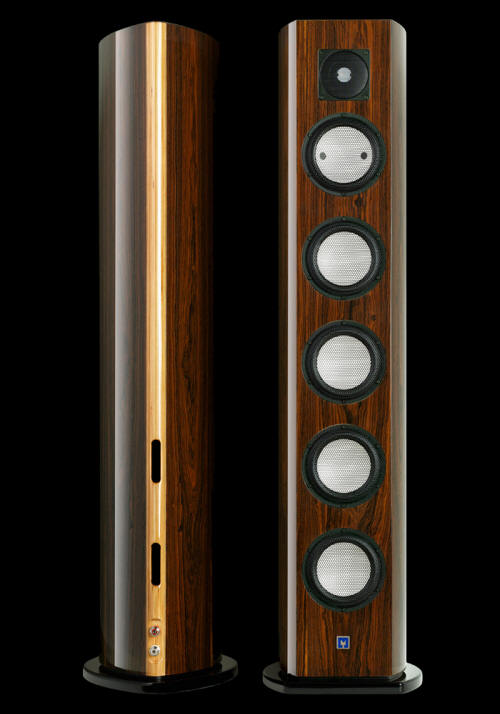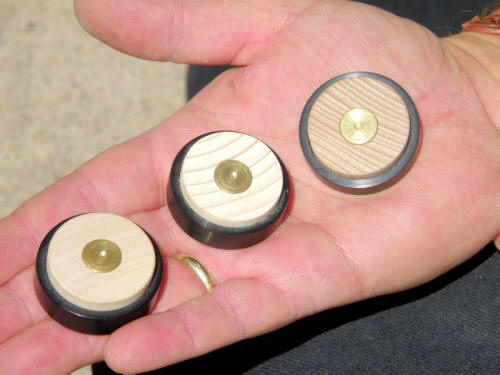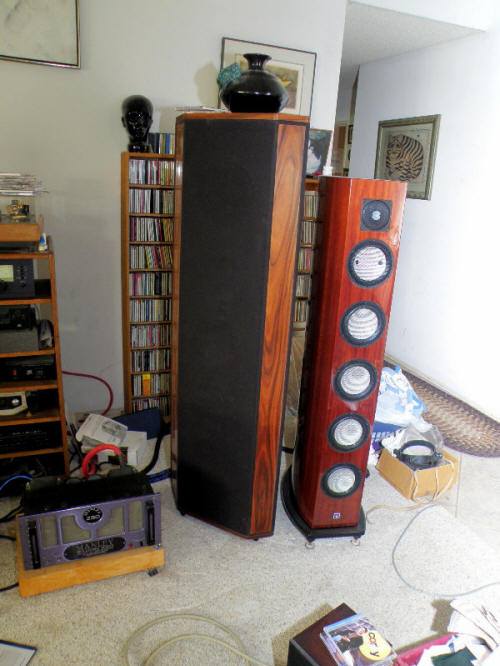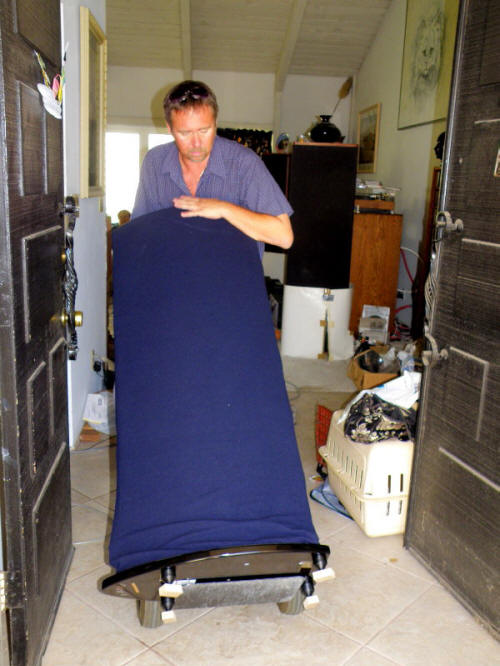
You are reading the older HTML site
Positive Feedback ISSUE
43may/june 2009
consensus audio
Conspiracy loudspeakers
as reviewed by Art Shapiro

|
ART SHAPIRO'S SYSTEM
LOUDSPEAKERS
ELECTRONICS
SOURCES
CABLES
ACCESSORIES
|
I never expected to go to THE Show. There I was at the annual banquet of my audio society. Early in the game, it was decided to draw one of the many raffle prizes. This was four days and three nights at a nice hotel and admission to THE Show in Las Vegas, courtesy of THE Show's president, Richard Beers. As the club photographer, I was ready to snap the obligatory picture of the lucky winner.
And to my utter horror, the number drawn was mine!
Many of the ballroom full of people knew of my intense aversion to travel and were either broadly grinning or laughing uncontrollably. The others sensed something was wrong from my grotesquely pained expression and my complexion which had turned a particular shade of green reminiscent of Immigration and Naturalization Service vans. I was doomed.
The next several weeks were spent fervently hoping for the end of the world. Alas, this didn't happen and I found myself in the alien world of Las Vegas, sitting in a weird suite complete with a large round bathtub in the middle of the bedroom.
I ambled over to the audio show in the next hotel, received my credentials at the registration desk, and ventured into the sprawling array of buildings that housed the various exhibits—several per building. The rather sparse crowds were actually somewhat unnerving to one who was used to the cattle-car conditions of the Stereophile Show and its subsequent renaming(s). Indeed, expecting intense crowds, and carrying "only" an audiophile tag rather than my usual press credentials, I hadn't even bothered to bring any of my own CDs, expecting little opportunity to request they be auditioned. In retrospect, that was a major gaffe on my part.
Early in the afternoon on the first day of the event I moseyed into room 1710. This was a decidedly good-sized room with a banner on the rear wall proclaiming the unfamiliar name of Consensus Audio. There were what appeared to be moderately-sized columnar loudspeakers with multiple drivers in a vertical configuration. They appeared to be almost bright red under the room lighting, so I figured they were some sort of artificial substance that could be made in any color. I'm not particularly a traditionalist, so I was not in the least offended by the sight of red loudspeakers.
I sat down to listen and it became almost immediately evident that I had encountered a significant audio system. The system was clear, powerful, and authoritative, while still being musical without the least intrusion of sterility. I sat for more than half an hour as various CDs of different genres were played and was frankly delighted with what I was hearing. As one for who solo piano constitutes more than 90% of his personal listening, I asked if anything appropriate could be found. Negative, but I recall that a chamber work with piano, the specifics of which I don't recall, was played and confirmed my already-high opinion of that room.
The next day, along with my wife, I went back to that room. She is by no means an audiophile and often doesn't care about the equipment that passes through my home, though she will occasionally voice a pro or con opinion on something. Soon she was praising the sound we were both hearing.
I introduced myself to the gentleman running the room who turned out to be Alfred Kainz, the U.S. distributor of this speaker line. I learned that they were an Austrian product associated with a designer formerly with Lumen-White. I'd encountered Lumen-White in the past and been quite impressed by their sonics. While these loudspeakers were not particularly warm, they were certainly easily within the tonal range that I consider reasonable. Alfred showed me a brochure: the loudspeakers were somewhat untraditional in that the sides curved inward to a truncated point at the rear, which featured a couple of vertical ports. Oddly, the loudspeakers were hollow—no fill of any sort. I learned that this model, the "Conspiracy", was at roughly $42,000—the middle of this company's product line, with higher products at roughly $78K and $108K. I groveled appropriately at this information. I was getting more and more impressed with this system so I introduced myself as a member of the reviewing staff of Positive Feedback Online.
The scene shifts to Southern California ten days later, where an SUV pulls up with a large U-Haul trailer in tow. Inside the SUV are Alfred Kainz, his wife Betty, and their Bichon-frieze Maxie. Inside the U-Haul are two rather impressive sarcophagus-like crates. And soon my ESP Concert Grands are being pushed aside in favor of the Conspiracies. They are finished in a beautiful reddish-brown African wood called Etimo, which my World Woods in Color book terms "Etimoé"; Alfred described it as a non-endangered wood reminiscent of Rosewood. These loudspeakers are absolutely gorgeous. I believe Alfred will attest to my complete astonishment in learning that these were the same pair as heard at the show; which I had thought were bright red. (Guess I never walked up to eyeball them close-up!) It had merely been an optical illusion from the lighting in that particular room. They are about 2/3 the size of my earlier (circa 1996) Concert Grands, and at 128 pounds a pop, roughly half the weight.

The Conspiracies being uncrated in the reviewer's driveway.
The loudspeakers came with three different sets of spikes, differing in the hardness of the wood that constitutes one of the layers in the spikes. Alfred felt that the middle set would be appropriate for my carpeting on concrete slab home, and I must confess to being happy enough not to try and manhandle the loudspeakers by trying the other spikes during my two months with the Conspiracies. The loudspeakers are not bi-wire-able so I intended to simply double up my shot-gunned Luminous speaker cables. Fortunately, Alfred had brought the Concensus speaker cable—a satisfyingly impressive single-wired product that I used for the entirety of my time with the loudspeakers. I also disconnected the REL subwoofer from the system with the idea that it might detract from the evaluation of the Consensus' sound.

The hardness and grain of the wooden layer affects the spikes' sound.

The Conspiracies are considerably smaller than the ESP Concert Grands.
Being fairly efficient loudspeakers, I realized that my big Manley monoblocks would not be particularly stressed driving them. We fired up the system and put on a piano CD, not for any critical listening, but merely to ensure that the system was functional. Just as I remembered from the show: it was powerful, well-articulated, and musically involving. I was grinning knowing that this was going to be a very pleasant tenure.
I decided to try a brief orchestral piece so I grabbed a Chandos disk of the six Elgar Pomp & Circumstance marches. I happened to arbitrarily pick the last of them, which starts with a huge crashing orchestral crescendo. What I didn't remember is that this particular CD is recorded at quite a high level, far more than the piano CD we had just briefly played at a more reasonable (and yet still high-ish) volume.
When that first crashing chord went off I was thankful that I had cathedral ceilings in the listening room or I might have been concerned with repairing a number of face indentations in a more normal ceiling. Yes, we all jumped… Big Time!
Clearly this system was sounding good—Very Good. The huge crates were put back into the U-Haul and away went Alfred, Betty, and Maxie. And I was alone with the Conspiracies, easily the most expensive component I'd ever had in my listening room.
With five cats I was terrified about the potential damage they might impart to these megabuck loudspeakers. Happily for me they had no feline-attracting grill cloths. The five midrange and bass drivers, although exposed, were well protected with open metal lattices. And let's say right off the bat that my wife, never particularly fond of my big Concert Grands (which I personally think are lovely components), raved throughout their stay about the Conspiracies' gorgeous aesthetics. She gave them an A+ in the proverbial Wife Acceptance Factor category. I guess, in the interest of political correctness, I should term that Spouse Acceptance Factor. Given the moderate size, the spectacular wood, the interesting shape, and the attractively-exposed drivers, I would be hard-pressed to quibble with her opinion of the loudspeakers.
It was already quite apparent that the Conspiracies were compatible with my particular mix of equipment, and furthermore that my ultimate assessment of the loudspeakers would be not only positive, but highly positive.
Needless to say—you're dealing with a piano aficionado here—my first couple of days with the loudspeakers would be devoted exclusively to the piano repertoire, and so I decided to pull out several of my very favorite CDs to start things out. I picked a Melodia CD of Russian virtuoso Sergei Tarasov performing a live recital. My initial intent was to play a little of the first track—the first movement of a light and melodious Schubert sonata—and then quickly switch to a few minutes of the last track, the mammoth, sprawling "Scriabin Fantasy in f# minor."
So I hit ‘Play' and… I played the whole CD in absolute entrapment; unable/unwilling to sample it as I had expected. The sense of power, the silvery upper register of the piano, the clarity and articulation of the complex music, and the gratifyingly assertive impact of the lower end of the keyboard were remarkable—indeed almost mesmerizing.
Once the CD was over, and after my dropped jaw had come pretty much back to its normal position and stopped grinning, something hit me. The Manley Neo 250 monoblocks have the ability to switch between tetrode mode and triode mode with the flick of a toggle switch on each front panel. Tetrode mode is more powerful and assertive while triode mode is sweeter and more melodious. With my ESP Concert Grands and the Neo 250s, both surprisingly delicate and refined products, there was never any question that tetrode mode was mandatory; while the combo makes an eminently valid and listenable system, I've always wanted more power and "kick ass" impact. But here I was with the Conspiracies, considerably further toward the power end of the spectrum than the Concert Grands. I flipped the switches to triode mode suspecting that this in itself just might improve the remarkable sound I was experiencing that much more.
I put on Impressions of France, an MCA disk of French piano music performed by Cristina Ortiz, figuring that the grace that so typifies French music would be a valid auditioning vehicle for the triode-reconfigured system. Once again, I expected to play just parts of several bands that typify the French repertoire: a Debussy Arabesque, the brooding "Mélancolie" of Poulenc, and the rippling "Jeux D'eau" of Ravel. And once again I played the entire CD!
The overall impression of grace and savoir faire, the scintillating clarity of the machine-gun runs in Ravel's Alborado del Gracioso, and the ability to sing and produce melody in the minimalist simplicity of Satie's famous Gymopédie #1 left me utterly astounded.
I left the Manleys in triode mode for the remainder of my time with the Conspiracies.
I couldn't move (reluctantly) to other forms of music without playing the wonderful and award-winning CD Earl Wild, The Romantic Master on Sony. Here Mr. Wild plays piano transcriptions of various orchestral works (he composed most, if not all, of the piano transcriptions of various orchestral works on this release). I expected to play the first couple of finger-twisting tracks, "Le Rouet d'Omphale" by Saint-Saëns, and the increasingly complex set of variations on Handel's "The Harmonious Blacksmith." Then I'd finish with the amazingly effective "Reminiscences of Snow White," based on several themes from that Disney movie; this is an extraordinarily captivating piece of music.
And you shouldn't be surprised by now to learn that once again I played the whole CD. Those first two tracks were a joy with their wide range of pianistic expression - from legato melodic passages to rapid-fire runs up and down the keyboard all presented in a stellar fashion. The Disney variations really encompass much of what the piano has to offer: from staccato passages at the extreme low end of the keyboard, to beautiful, flowing melodic passages, to high-speed virtuosic runs up and down the entire range. The Conspiracies excelled in everything. The bass extension seemed to be roughly equivalent to that of my much-larger Concert Grands. The articulation of those impossible finger-twisting runs was spectacular without being unpleasantly sterile. The microdynamics of the music could not be faulted.
One track, the Tchakovsky (as arranged by Pabst) "Paraphrase on Sleeping Beauty," has three distinct sections that typify the capabilities of the modern concert grand piano. The first minute and a half is, perhaps, some of the most savagely powerful music in all piano repertoires. This is followed by about five minutes of delicate una corda (soft pedal) music and finally the heavens open up with a profusion of notes so overwhelming that they could probably save money by purchasing black paper and printing the white around the notes. The Conspiracies simply excelled in all three sections. The power and clarity of the first section clearly bested my own non-trivial loudspeakers. The delicacy and, let me use the same term again, silvery trebles of the middle section were remarkable. The musical articulation and ability to delineate the intense profusion of notes in the final minutes were a thing of beauty. Hearing piano through the Conspiracies was simply a privilege that unfortunately few will experience.
I've probably bored you enough with respect to the piano; will you accept that what I heard through the Conspiracies was remarkable? Power, resolution, musicality, delicacy, texture, tonality. You name it; it was spectacular, effective, listenable, and a joy to experience.
I played dozens of piano CDs during my time with these loudspeakers, everything from Mozart to Chopin to Granados to the percussive modernism of Prokofiev. I loved every minute of what I heard from the Conspiracies.
So now it was time to move on to the orchestral repertoire. I wanted to play some music of Hungarian composer Zoltán Kodály on a Koss CD which can be quite diverse with its flowing string passages, percussive snare drum passages, fairly "thick" and complex sections for the entire orchestra, and even music for that archetypically Hungarian instrument, the cimbalom. The Conspiracies handled the orchestra as effectively as they had the piano: clear, powerful, and melodious presentation, able to resolve the complexity of the music without being tiresome or excessively assertive. From thundering orchestral climaxes to delicate single-instrument solo sections, everything was terrific. The tonal balance, the dynamics, the ability to effectively reproduce large-scale and small-scale sections, all was spot on. Everything simply confirmed my assertion that I had encountered an extremely significant pair of loudspeakers.
I moved to a favorite sampler CD on Sony. I've always enjoyed a track from Mahler's "Des Knabens Wunderhorn" featuring famed baritone Diedrich Fischer-Dieskau singing with the Berlin Philharmonic. There is very heavy use of the bass drum in this particular piece, ranging from lightly hit to savagely whacked. The bass drum is an interesting instrument in that it really does have a defined tonality despite the relatively low frequency. A bad speaker just reproduces some sort of vague low-frequency noise; an excellent system makes one conscious that there is a musical tone behind that noise. It should come as no surprise that the listener could be fully conscious of the drum's musical characteristics while appreciating the sense of power that was appropriately presented on both soft and double forte strokes. And the delightful clarity of Mr. Fisher-Dieskau's voice was enhanced by the extraordinary resolving ability of the Conspiracies. Along with the gorgeous melodiousness of his famed rich baritone voice, the enunciation of the German words was spectacularly clear. Who says you can't have your cake and eat it too?
Unlike many audiophiles, I tend to be relatively insensitive to spatial aspects of musical reproduction, both in my system and in real life, unless things are unusually good or unusually bad. I thought that two small-scale non-classical works might offer some insight into this characteristic. I put on Standin' in the Safety Zone on Warner Brothers and was struck by the gorgeous tonality of a capella voices, not to mention the exceptional presence of this well-recorded CD. The sound spread appropriately through my listening room and I felt that the vocalists were quite distinct and well placed in the soundstage. Ditto for the Crescent Crawl performed by the Bruce Katz band on Audioquest. The impact of the snare drum, the "blattiness" of the sax, the deep resonant impact of the electric bass, and the percussive impact of the piano were thoroughly enjoyable; the individual instruments seemed well localized in space.
In order to understand the deep bass capacity of these remarkable loudspeakers, I put on the John Rutter Requiem on a Reference Recordings CD, concentrating on the "Pie Jesu" track and its magnificent deep organ pedal notes. In a bigger room than mine, with the right loudspeakers, the pedal notes can shake your guts! My Concert Grands will reproduce some of this ultra-low end and with the Rel subwoofer, normally part of the system, one can at least have one's guts vibrated, though not severely jostled! I'd say that the Conspiracies were approximately the equal of the much-larger Concert Grands in this respect, probably not falling off until at least the mid 20s and maybe a smidge lower than that. That's pretty impressive in my book; I wonder what would happen in a room larger than mine.
Given that these loudspeakers were somewhat more assertive and extroverted than my Concert Grands, although (I hope it's obvious) not to a degree that exceeded the bounds of good audio taste, I wondered what would happen given a CD with sonic problems for which this presentation might be too overwhelming. I turned to a Hyperion CD of the two-piano suites of Russian composer Anton Arensky which features closely mic'd, clattery, rattling pianos, that in the wrong system, can be positively irritating. I thought this particular CD might be "over the edge" on the Conspiracies given how it sounds on my own far-more-mellow loudspeakers and was prepared to alibi that what I was hearing is hardly the fault of the loudspeakers and quite understandable given the flawed recording. To my considerable surprise, the sound, while still being aggressive and clattery, didn't push things so far as to be un-enjoyable. I really can't explain it; this really should have been the boundary condition where I wouldn't like what I was hearing. Life is strange, isn't it?!
My subsequent listening to various other musical offerings included solo guitar, solo harp, chamber music, vocal recitals, etc., etc. These only served to confirm what I'd already experienced and as such there is little to be gained by discussing them as it would only reinforce what I've tried to say here. The Consensus Conspiracies are a remarkable product. Not overwhelming in either size or weight, they are physically attractive and were a lovely addition to my listening room. They are not a tonally warm or rich loudspeaker in that they definitely move more towards the assertive and clear side of things; though they are certainly well within that range of sound that in some sense can be thought of as "valid and reasonable". Their power and clarity are spectacular and this is all pulled off without being thin or sterile. Tonal balance is remarkable from top to the considerably deep bottom-end and the silvery piano trebles are utterly captivating.
I have long been a fan of the similarly-priced JM Labs Utopia line of loudspeakers, a product that has brought tears to these jaded eyes and turned your reviewer into a quivering mass of protoplasm. The Consensus Conspiracies move right into that upper echelon of audio artistry. The different sonic signatures of the two products are merely matters of taste; it would take someone more philosophical than I to say that one was right and one was wrong. Both are extraordinarily powerful loudspeakers where the Utopias might be a little richer and the Conspiracies a little more articulate. If I can be permitted an analogy that might make sense to a few readers, and with apologies to the rest of you: if the JM Labs Utopia were a rich, sonorous, sweeping Mahler symphony, the Consensus Audio Conspiracies would be a brash and brassy Bruckner symphony. Both do what they were designed to do: to attain sonic pinnacles that are a privilege to behold.
Obviously $42,000 is a huge expenditure for most of us and economic realities restrict a magnificent product like this to relatively well-heeled audiophiles. I was so sorely tempted to purchase the review sample, but when one is employed by a company whose name is so often prefaced by the two words "Financially troubled", I sadly forced myself to say goodbye to them as Alfred, Betty, Maxie, and the U-Haul returned to haul them away forever. Should you be able to play in this lofty financial ballpark, it would be almost criminal for you to not devote serious auditioning effort to the Consensus Audio Conspiracies. Art Shapiro

Alfred Kainz wheels one of the Conspiracies out of the house. Not shown: PFO reviewer sobbing inconsolably as they are taken away.
Conspiracy loudspeakers
Retail: $42,000 a pair
Highend Electronics
web address:
www.highend-electronics.com
Consensus Audio
web address:
www.consensusaudio.com

